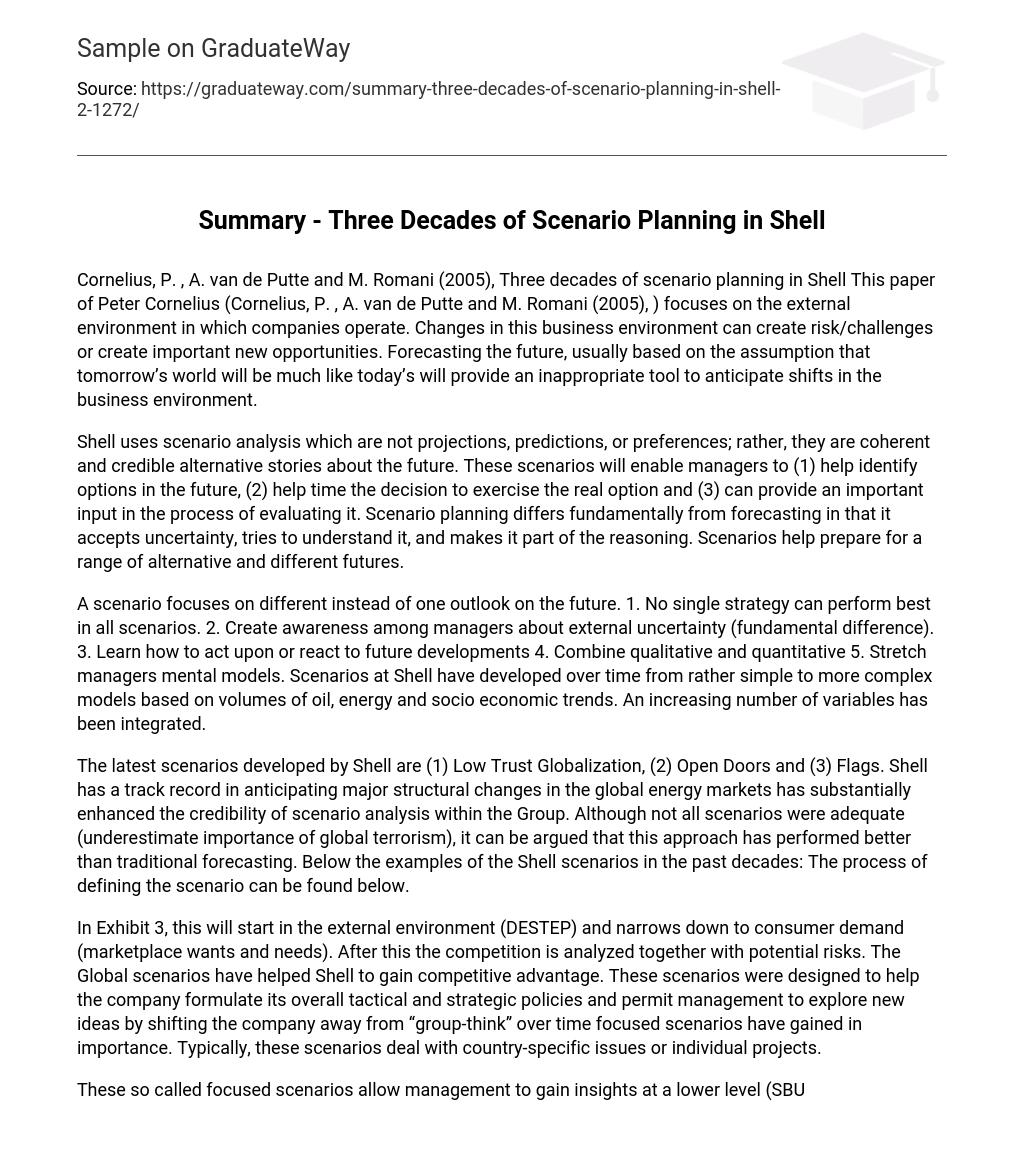The article by Peter Cornelius, A. van de Putte, and M. Romani (2005) discusses three decades of scenario planning in Shell. It emphasizes the significance of the external environment in business operations. Changes in this environment can pose risks or offer valuable opportunities. Traditional forecasting methods that assume the future will be similar to the present are ineffective in anticipating shifts in the business environment.
Shell utilizes scenario analysis, which involves the creation of coherent and credible alternative stories about the future that are not projections, predictions, or preferences. These scenarios serve several purposes: (1) identifying future options, (2) determining the timing for exercising real options, and (3) providing valuable input for evaluating said options. Unlike forecasting, scenario planning embraces uncertainty, seeks to comprehend it, and incorporates it into the decision-making process. By preparing for various alternative and diverse futures, scenarios aid in proactive readiness.
A scenario focuses on different instead of one outlook on the future. 1. No single strategy can perform best in all scenarios. 2. Create awareness among managers about external uncertainty (fundamental difference). 3. Learn how to act upon or react to future developments 4. Combine qualitative and quantitative 5. Stretch managers mental models. Scenarios at Shell have evolved over time from relatively basic to more intricate models based on volumes of oil, energy, and socio-economic trends. An expanding range of variables has been incorporated.
Shell has developed three new scenarios: Low Trust Globalization, Open Doors, and Flags. The company’s history of predicting global energy market changes has greatly improved the credibility of scenario analysis within Shell. While some scenarios may have underestimated the significance of global terrorism, this approach has generally been more effective than traditional forecasting. Examples of past Shell scenarios can be found below.
Exhibit 3 begins by analyzing the external environment (DESTEP) and then focuses on consumer demand (marketplace wants and needs). The competition and potential risks are also examined. Shell has gained a competitive advantage from the Global scenarios, which were created to guide the company’s tactical and strategic policies and encourage new ideas. The use of scenarios has helped the company move away from “group-think” and has become increasingly significant over time. These scenarios often address country-specific issues or individual projects.
Management can gain insights at a lower level (SBU or project) through these focused scenarios. Choosing projects using real options offers multiple advantages. Relying on a single outcome can limit our choices, but scenarios can help by uncovering various pathways. The real options approach is particularly beneficial for making financial project decisions, as it helps managers strategize future opportunities and potential value resulting from current investments.
This tool is helpful in situations with high uncertainty, when calculating the Net Present Value (NPV) or Discounted Cash Flow (DCF) may not provide a reliable estimate. It is important to note that certain markets face challenges due to limited historical guidance and high volatility. Two main factors influence future payoffs, leading to differences from past payoffs. The first factor involves decisions made by the company, which are typically related to specific projects or sectors and easy to identify. The second factor pertains to external factors beyond the firm’s control (DESTEP).
The use of real options analysis in uncertain environments can be especially beneficial for staged investment decisions. An example is given of a 5-stage approach where each stage acts as a call option for the value of continuing exploration, including all future options. Scenario planning is emphasized as a method for identifying causal linkages among various factors within and beyond the firm’s control. It is important to note that scenarios are not forecasts and must be used alongside specific tools for project selection in strategic planning. In certain situations, utilizing real options analysis and scenarios may lead to different conclusions compared to solely relying on DCF analysis, potentially resulting in the rejection of certain investments. In summary, scenario planning is introduced as a method suitable for strategic planning in highly uncertain environments, providing managers with multiple potential futures by considering various variables in the model.
Within an organization, scenarios are developed at various levels (global, focused, and project) to prevent groupthink and encourage the exploration of new ideas. The real options approach is particularly useful at the project level, as a project’s value may change over time due to new information. These scenarios serve three purposes for managers: (1) identifying future options, (2) determining the optimal timing for exercising the real option, and (3) providing valuable input for evaluation.





